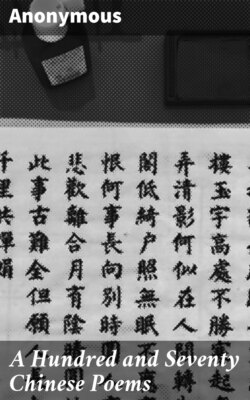Читать книгу A Hundred and Seventy Chinese Poems - Anonymous - Страница 9
TECHNIQUE
ОглавлениеCertain elements are found, but in varying degree, in all human speech. It is difficult to conceive of a language in which rhyme, stress-accent, and tone-accent would not to some extent occur. In all languages some vowel-sounds are shorter than others and, in certain cases, two consecutive words begin with the same sound. Other such characteristics could be enumerated, but for the purposes of poetry it is these elements which man has principally exploited.
English poetry has used chiefly rhyme, stress, and alliteration. It is doubtful if tone has ever played a part; a conscious use has sporadically been made of quantity. Poetry naturally utilizes the most marked and definite characteristics of the language in which it is written. Such characteristics are used consciously by the poet; but less important elements also play their part, often only in a negative way. Thus the Japanese actually avoid rhyme; the Greeks did not exploit it, but seem to have tolerated it when it occurred accidentally.
The expedients consciously used by the Chinese before the sixth century were rhyme and length of line. A third element, inherent in the language, was not exploited before that date, but must always have been a factor in instinctive considerations of euphony. This element was “tone.”
Chinese prosody distinguishes between two tones, a “flat” and a “deflected.” In the first the syllable is enunciated in a level manner: the voice neither rises nor sinks. In the second, it (1) rises, (2) sinks, (3) is abruptly arrested. These varieties make up the Four Tones of Classical Chinese.[1]
The “deflected” tones are distinctly more emphatic, and so have a faint analogy to our stressed syllables. They are also, in an even more remote way, analogous to the long vowels of Latin prosody. A line ending with a “level” has consequently to some extent the effect of a “feminine ending.” Certain causes, which I need not specify here, led to an increasing importance of “tone” in the Chinese language from the fifth century onwards. It was natural that this change should be reflected in Chinese prosody. A certain Shēn Yo (A.D. 441–513) first propounded the laws of tone-succession in poetry. From that time till the eighth century the Lü-shih or “strictly regulated poem” gradually evolved. But poets continued (and continue till to-day), side by side with their lü-shih, to write in the old metre which disregards tone, calling such poems Ku shih, “old poems.” Previous European statements about Chinese prosody should be accepted with great caution. Writers have attempted to define the lü-shih with far too great precision.
The Chinese themselves are apt to forget that T’ang poets seldom obeyed the laws designed in later school-books as essential to classical poetry; or, if they notice that a verse by Li Po does not conform, they stigmatize it as “irregular and not to be imitated.”
The reader will infer that the distinction between “old poems” and irregular lü-shih is often arbitrary. This is certainly the case; I have found the same poem classified differently in different native books. But it is possible to enumerate certain characteristics which distinguish the two kinds of verse. I will attempt to do so; but not till I have discussed rhyme, the other main element in Chinese prosody. It would be equally difficult to define accurately the difference between the couplets of Pope and those of William Morris. But it would not be impossible, by pointing out certain qualities of each, to enable a reader to distinguish between the two styles.
Rhyme.—Most Chinese syllables ended with a vowel or nasal sound. The Chinese rhyme was in reality a vowel assonance. Words in different consonants rhymed so long as the vowel-sound was exactly the same. Thus ywet, “moon,” rhymed with sek, “beauty.” During the classical period these consonant endings were gradually weakening, and to-day, except in the south, they are wholly lost. It is possible that from very early times final consonants were lightly pronounced.
The rhymes used in lü-shih were standardized in the eighth century, and some of them were no longer rhymes to the ear in the Mandarin dialect. To be counted as a rhyme, two words must have exactly the same vowel-sound. Some of the distinctions then made are no longer audible to-day; the sub-divisions therefore seem arbitrary. Absolute homophony is also counted as rhyme, as in French. It is as though we should make made rhyme with maid.
I will now attempt to distinguish between Ku-shih (old style) and Lü-shih (new style).
Ku-shih (Old Style).
(a) According to the investigations of Chu Hua, an eighteenth century critic, only thirty-four rhymes were used. They were, indeed, assonances of the roughest kind.
(b) “Deflected” words are used for rhyming as freely as “flat” words.
(c) Tone-arrangement. The tones were disregarded. (Lines can be found in pre-T’ang poems in which five deflected tones occur in succession, an arrangement which would have been painful to the ear of a T’ang writer and would probably have been avoided by classical poets even when using the old style.)
Lü-shih (New Style).
(a) The rhymes used are the “106” of modern dictionaries (not those of the Odes, as Giles states). Rhymes in the flat tone are preferred. In a quatrain the lines which do not rhyme must end on the opposite tone to that of the rhyme. This law is absolute in Lü-shih and a tendency in this direction is found even in Ku-shih.
(b) There is a tendency to antithetical arrangement of tones in the two lines of a couplet, especially in the last part of the lines.
(c) A tendency for the tones to go in pairs, e.g. (A=flat, B=deflected): AA BBA or ABB AA, rather than in threes. Three like tones only come together when divided by a “cesura,” e.g., the line BB / AAA would be avoided, but not the line BBAA / ABB.
(d) Verbal parallelism in the couplet, e.g.:
